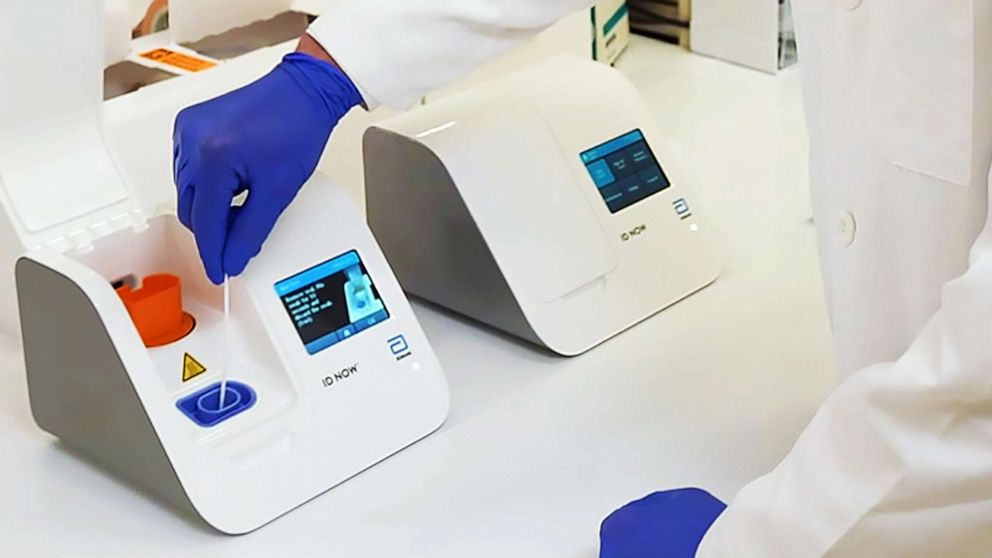[ad_1]
A new novel coronavirustest may make diagnosing COVID-19 as easy as the flu. The new point-of-care test, having just received an emergency-use authorization by the U.S. Food and Drug Administration (FDA), will be able to deliver results in as little as five minutes, according to the manufacturer.
This test from medical device company Abbott, which begins shipping April 1, may soon be available at your local urgent care clinic.
“This is going to be the fastest molecular point-of-care test to date,” said John Frels, Ph.D., Abbott’s vice president of research and development, in an interview with ABC News. “It generates a positive result in 5 minutes and negative results in 13 minutes.”
President Donald Trump called the test “a whole new ballgame” and in a recent tweet, Scott Gottlieb, former FDA commissioner, echoed these sentiments calling it “a game changer.” During Monday’s White House briefing, Trump brought the machine that will run the new COVID-19 test to the Rose Garden for a show-and-tell, calling the new rapid test “highly accurate.”
The test will run on the company’s existing ID NOW platform, a lightweight, portable machine around the size of a small toaster, which according to Abbott, is already the most widely available molecular point-of-care testing platform in the United States today and is used for illnesses like flu and strep. As a highly mobile platform, it can be used in a variety of healthcare settings, particularly physician offices and urgent care-type settings.
According to Frels, “what it’s really going to be able to do is fill the void, which is rapid results where they’re needed for patients who need them the most.” Until this point, testing has been a fraught process in the U.S. — with tests at first very difficult to come by and then results taking days. Testing has dramatically expanded since then, but results still take time.
The ID NOW machine can test samples one at a time. A health care provider would use a swab to take a sample from a sick patient’s nose or throat and then mix the swab into a chemical solution that breaks open the virus and releases its genetic material. The sample is then placed into the ID NOW instrument, which uses a special “isothermal technology” to replicate and amplify, if present in the sample, the small section of the virus’ genetic sequences in order to quickly detect whether a person is positive or negative for COVID-19, according to Frels.
Frels said that such a test will allow frontline health care workers to see a patient, quickly diagnose them and make immediate decisions regarding treatment and care, helping prevent further transmission of the virus to other people. “Diagnostics in general, stepping back from this, play into about 70% of therapeutic directional decisions. It’s difficult to know where to go unless you have a test result in front of you,” Frels said.
According to Adm. Brett Giror, the assistant secretary for health at the Department of Health and Human Services, there are about “18,000 of these little toaster-sized machines” across doctor’s offices and hospitals across the country. The company does not expect all 18,000 machines to run the test. Abbott will initially supply 50,000 tests a day, with the goal to ramp up test supply to over a million a month. According to the company, the cost of the test is expected to be comparable to the ID NOW flu test and will be covered by most insurance plans.
“This will fill a great need that is not being well served at this point,” said Frels.
With the ID NOW machines already widely available across the country, the infrastructure is already in place to allow for a smooth integration of the rapid COVID-19 test into the health care sphere, which may help speed up and broaden testing and more effectively curb the pandemic. Abbott is working with the White House to deploy the first batches of tests to urgent care clinics, doctors’ offices, and emergency rooms in areas that are hardest hit.
Frels says that this test will “complement the other side of the equation,” referring to high volume, high throughput style COVID-19 diagnostic instruments, such as Abbott’s m2000 Real Time system, which received emergency use approval from the FDA last week. That system, which uses a standard molecular detection technology called PCR to detect COVID-19’s genetic sequence in a sample, may take a number of hours to produce results, but can process more samples simultaneously (about 470 tests a day), making it suitable for large hospital settings with multiple patients who require testing.
Although the test has the potential to address the country’s testing shortage, healthcare workers still need personal protective equipment to protect themselves when administering these tests. This equipment, like masks, eye protection, and gowns, are still in short supply.
What to know about Coronavirus:
[ad_2]
Source link

